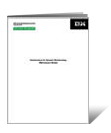

| EDUCATION |
|
TDWI Business Intelligence Fundamentals:
From Data Warehousing to Business Impact TDWI Project Management for Business
Intelligence Leading and Organizing Business
Intelligence Teams: Improving Individual and Team
Performance |
| WHITE PAPERS | |
|
| WEBINARS | ||||||||||||||||||
|
||||||||||||||||||
| ABOUT TDWI EXPERTS |
TDWI Experts is a twice-monthly e-newsletter where BI/DW thought leaders share opinions and commentary about relevant industry topics and the latest technologies. |


November 18, 2010
Dual BI Architectures: The Time Has Come
Wayne W. Eckerson
Topic: BI Architectures
As a parent, by the time you have your second or third child, you know which battles to fight and which to avoid. It's time we did the same in business intelligence (BI). For almost two decades we've tried to shoehorn both casual users and power users into the same BI architecture, but the two don't play nicely together. Given advances in technology and the explosion in data volumes and types, it's time we separate them and create dual BI architectures.
Mapping Architectures
Casual users are executives, managers, and front-line workers who periodically consume information created by others. They monitor daily or weekly reports and occasionally dig deeper to analyze an issue or get details. Generally, a well-designed interactive dashboard or parameterized report backed by a data warehouse with a well-designed dimensional schema is sufficient to meet their information needs. Business users who want to go a step further and build ad hoc views or reports for themselves and peers -- whom I call Super Users -- are best served with a semantic layer running against a traditional data warehouse.
Power users, on the other hand, explore data to answer unanticipated questions and issues. No predefined dashboard, report, or semantic layer is sufficient to meet their needs. They need to access data both in the data warehouse and outside of it, beyond the easy reach of most BI tools and predefined metrics and entities. They then need to dump the data into an analytical tool (such as Excel or SAS) so they can merge and model the data in novel and unique ways.
For years, we've tried to reconcile casual users and power users within the same BI architecture, but it's a losing cause. Power users generate "runaway" queries that bog down performance in the data warehouse, and they generate hundreds or thousands of reports that overwhelm casual users. As a result, casual users reject self-service BI and revert back to old habits of requesting custom reports from IT or relying on gut feel. Meanwhile, power users exploit BI tools to proliferate spreadmarts and renegade data marts that undermine enterprise information consistency while racking up millions in hidden costs.
Time for a New Analytic Sandbox
Some forward-looking BI teams are now creating a separate analytic architecture to meet the needs of their most extreme power users. They are relegating their data warehouses and BI tools to handle standard reporting, monitoring, and lightweight analysis.
Compared to a traditional data warehousing environment, an analytic architecture is more free-form, with fewer rules of engagement. Data does not need rigorous cleaning, mapping, or modeling, and hardcore business analysts don't need semantic guardrails to access the data. In an analytic architecture, the onus is on the business analyst to understand source data, apply appropriate filters, and make sense of the output. Certainly, it is a "buyer beware" environment. As such, there may only be a handful of analysts in your company who are capable of using this architecture, but the insights they generate may make the endeavor well worth the effort and expense.
Sponsored Links |
Types of Analytic Architectures
There are many ways to build an analytic architecture. Below are three approaches. Some BI teams implement one approach; others mix all three.
Physical Sandbox. One type of analytic architecture is uses a new analytic platform -- a data warehousing appliance, columnar database, or massively parallel processing (MPP) database -- to create a separate physical sandbox for their hardcore business analysts and analytical modelers. They offload complex queries from the data warehouse to these turbocharged analytical environments, and they enable analysts to upload personal or external data to those systems. This safeguards the data warehouse from runaway queries and liberates business analysts to explore large volumes of heterogeneous data without limit in a centrally managed information environment.
Virtual Sandbox. Another approach is to implement virtual sandboxes inside the data warehouse using workload management utilities. Business analysts can upload their own data to these virtual partitions, mix it with corporate data, and run complex SQL queries with impunity. These virtual sandboxes require delicate handling to keep the two populations (casual and power users) from encroaching on each other's processing territories. Compared to a physical sandbox, it avoids having to replicate and distribute corporate data to a secondary environment that runs on a non-standard platform.
Desktop Sandboxes. Other BI teams are more courageous (or desperate) and have decided to give their hardcore analysts powerful, in-memory, desktop databases (e.g., Microsoft PowerPivot, Lyzasoft, QlikTech, Tableau, or Spotfire) into which they can download data sets from the data warehouse and other sources to explore the data at the speed of thought. Analysts get a high degree of local control and fast performance but give up data scalability compared to the other two approaches. The challenge here is preventing analysts from publishing the results of their analyses in an ad hoc manner that undermines information consistency for the enterprise.
Dual, Not Dueling, Architectures
As an industry, it's time we acknowledge the obvious: our traditional data warehousing architectures are excellent for managing reports and dashboards against standard corporate data, but they are suboptimal for managing ad hoc requests against heterogeneous data. We need dual BI architectures: one geared to casual users that supports standard, interactive reports and dashboards and lightweight analyses; and another tailored to hardcore business analysts that supports complex queries against large volumes of data.
Dual architectures does not mean dueling architectures. The two environments are complementary, not conflicting. Although companies will need to invest additional time, money, and people to manage both environments, the payoff is worth the investment: companies will get higher rates of BI usage among casual users and more game-changing insights from hardcore power users.
Wayne W. Eckerson is the former director of TDWI Research


